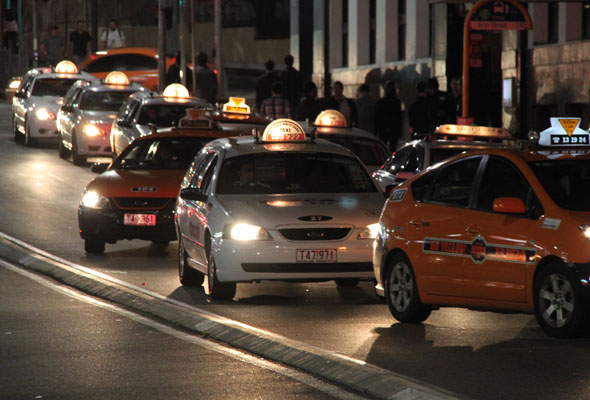
Brisbane taxi industry uncovered
An report on the Brisbane taxi industry investigated from the inside out and the findings might shock you.
 [/media-credit]
[/media-credit]
- Taxi’s competing for Friday night fares in Fortitude Valley.
Rivalry shaped Brisbane taxi industry
If you find yourself catching a taxi in the Brisbane area, chances are you’ll be getting in either a Black & White or a Yellow cab.
For consumers two companies means there is competition, which drives prices down, increases service standards and helps keep the businesses honest. For drivers, competition means there are opportunities for career progression.
Bill Parker, general manager of the Yellow Cab Company, believes that drivers and the customer are not that different in their expectations.
“Drivers and the public are very discerning in whatever they do,” Mr Parker said. “They [drivers] get to decide in what shifts they want to do and how frequently they work.
“A lot of our drivers are professionals, in between jobs, who choose to work part-time.”
According to the Yellow Cab’s website, the taxi industry during the 1950’s was a period of time “where the taxi drivers and companies showed open animosity to each other”.
The website lists marketing tactics, and the fact that they were a newly developed company as the main reasons for the hostility they experienced.
However, while Black & White and Yellow dominate the market today, there have been other companies to service the Brisbane metropolitan taxi district.
Ascot Taxi Service and Blue & White Taxis merged with Black & White Cabs as a way of survive against the might of Yellow.
“You had Ascot Taxis, that had to cease the service because they simply didn’t have enough cabs to service the area,” said Mr Parker.
“It is feasible to have more than two [taxi companies] but it all comes down to economics and survival,” he explained.
Lee Sims, former President of the Cab Drivers Association of Queensland, told Quest News that to survive in this industry there are a few things companies should be doing.
“It’s time we stopped blaming the driver and have a look at the person who gave them the license in the first place,” Mr Sims said.
“We want to have the safest drivers and taxis on the road for passengers.”
When asked why a customer would choose to travel with the Yellow Cab Company, Mr Parker agreed that the consumer is looking for exceptional levels of service and driving skills.
“It is not easy being a driver and Queensland has the best service anywhere because it is so disciplined,” continued Mr Parker.
“You tell me of another industry that does monthly criminal history and yearly traffic history checks [of the drivers].”
Black & White Cabs currently have a 900 strong fleet, whilst the Yellow Cab Company has 1100 taxis.
Black & White Cabs declined to comment.
[media-credit id=135 align=”aligncenter” width=”590″] [/media-credit]
[/media-credit]
Story by Amber Davidson.
